It will come as no surprise to anyone – especially the ladies out there – that the female reproductive cycle is a complex process that plays into so many facets of an individual’s physical health and mental wellness.
This feature release aims to unlock a new world of insights allowing you to better understand it’s impacts. In an effort to better support women’s health, we can now provide insights into how nutrition can affect mood, energy and overall wellbeing during the course of your cycle.
Not only can you gain valuable insights into what your body and its hormones are up to, you can leverage this information to help track and minimize symptoms. Experiment with adjusting your nutrient intake, exercise and sleep to better support your body’s processes.
The cherry on top is that we got to work with one of our favourite partners, ŌURA, to help launch our first foray into menstrual cycle tracking.
Our first iteration of cycle tracking within Cronometer is leveraging cycle data imported from ŌURA so is currently available to female users taking advantage of our ŌURA integration; however, we do plan to expand the feature so all users can take advantage of it in the near future.
Scroll down to read the full article or jump to the following sections if you’re interested in learning about a more specific area.
How Cycle Tracking In Cronometer Works
For more detailed instructions, visit our user manual for mobile or for web.
Include Cycle Tracking As An Imported Metric
First things first – make sure you’re on the latest version of the mobile app (4.12.0 or higher) or login via the web and re-authorize your ŌURA integration – meaning you’ll need to disconnect the integration and re-connect.
- Navigate to More > Connect Apps & Devices > Devices > ŌURA
- Make sure ‘Import Menstrual Cycle Day and Phase’ is toggled on in your imported metrics.
Cycle Tracking Settings
Once your data is syncing from ŌURA, you will see a Cycle Tracking widget on your Dashboard and a feature box on your Diary screen.
By default, both will appear, but if you only want to view one, you can toggle them on or off via More > Display > Dashboard Settings or Diary Settings.
On Your Dashboard
From your Dashboard, you’ll be able to see your imported metrics from ŌURA such as cycle day, cycle phase and body temperature variation.
Click the arrow in the top right corner of the widget to expand and read more information about the cycle phase.
Please note: Your cycle phase prediction can change throughout the day, much like the weather, and this data is only passed to Cronometer once ŌURA is confident about their prediction. This means that the cycle phase you see on your Dashboard will be from the prior day and not guaranteed to be your current cycle phase.

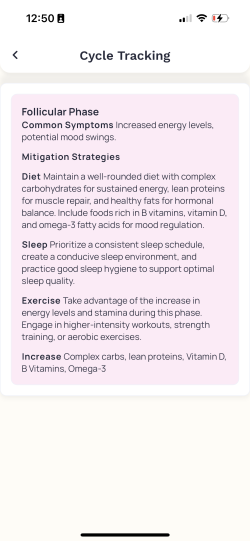
On Your Diary
From your Diary screen, you’ll see a box featuring data from the most recent import regarding your cycle day and cycle phase.
Click the ‘!’ icon to expand the widget and read more information about the cycle phase.
Please note: Your cycle phase prediction can change throughout the day, much like the weather, and this data is only passed to Cronometer once ŌURA is confident about their prediction. This means that the cycle phase prediction will only show up on your Diary for prior days. You will not get cycle phase information on the Diary on today’s date.
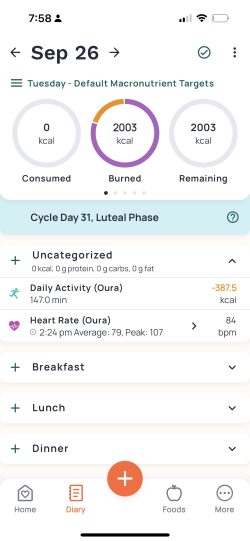
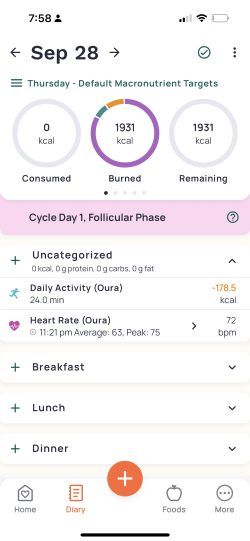
On A Chart
On the mobile app (soon to be released on web), you have the ability to visualize cycle phases in any Chart. This will be incredibly useful for gauging the impact of a specific cycle phase on your appetite (overall calorie intake) or cravings for certain groups of nutrients like carbs or fats.
You can also chart how your cycle phase may be affecting your weight, your sleep, your mood, your energy and your exercise levels. Here’s some additional inspo for different ways you can leverage the Charts feature.
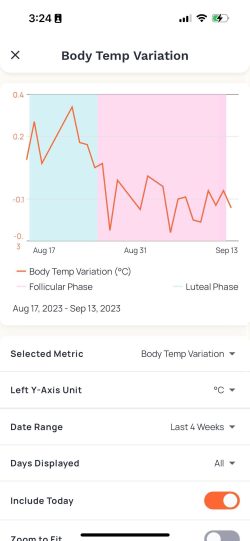
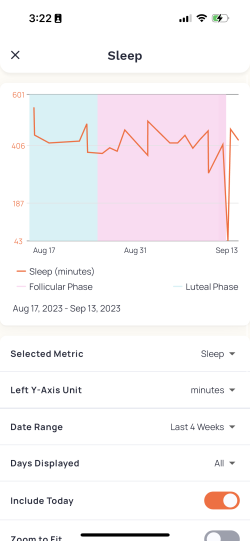
Leveraging Your Cycle Data
Currently, we’re importing data from Oura which analyzes temperature variation to predict whether you’re in the Follicular or Luteal phase of your menstrual cycle. More details on ŌURA’s methods can be found here.
While there are four cycle phases that are commonly referred to – Follicular, Menstrual, Luteal and Ovulation – we’re currently showing data pertaining to the Follicular and Luteal Phases.
Read below to learn more about the Follicular and Luteal Phases, what they might mean for your energy levels, mood and which nutrients you should be paying the most attention to during this time.
Follicular Phase
During this phase, the hypothalamus triggers the pituitary gland to release follicle stimulating hormone to trigger follicle/egg maturation. Your estrogen levels rise, which supports energy in this phase.
You may feel increased energy levels and a more stable mood.
Both energy level and mood can be tracked in Cronometer as a biometric. Recording these daily will help you identify trends when looking back at your data over time.
Diet Considerations During The Follicular Phase
- Maintain a well-rounded diet with complex carbohydrates for sustained energy, lean proteins for muscle repair, and healthy fats for hormonal balance. Include foods rich in B vitamins, vitamin D, and omega-3 fatty acids for mood regulation.
- Support estrogen production and metabolism with essential fatty acids and Vitamin E. Try ground flax, flax oil or raw pumpkin seeds. Probiotics also support healthy gut flora which supports healthy estrogen levels.
- Decrease or eliminate foods that contain harmful estrogen or the estrogenic chemicals such as PCBs, dioxin, phthalates and BPA. These can promote estrogen dominance and are linked endometriosis, menstrual pain, fibroids, and cysts.
- Support testosterone production and increase your Zinc intake. Try pumpkin seeds.
- Support your upcoming ovulation phase with Selenium rich foods which include meat like pork, beef, or lamb as well as fish, eggs and nuts.
Consider Increasing
- Complex carbs
- Lean proteins
- Vitamin D
- B Vitamins
- Omega-3
- Zinc
- Selenium
- Probiotics
Sleep Considerations During The Follicular Phase
Try to prioritize a consistent sleep schedule, create a conducive sleep environment, and practice good sleep hygiene to support optimal sleep quality.
Exercise Considerations During The Follicular Phase
This is when estrogen and testosterone are increasing and it may be easier to build muscle. Take advantage of the increase in energy levels and stamina during this phase. Engage in higher-intensity workouts, strength training, or aerobic exercises.
Luteal Phase
Once the egg is released it develops into a corpus luteum. The corpus luteum releases progesterone and some estrogen. This is what triggers the development of the menstrual lining. If you get pregnant, the level of HCG rises dramatically to support the lining, if not, the corpus lutem shrinks/resorbs which causes the levels of progesterone and estrogen to drop. The fall in estrogen and progesterone is what triggers the lining to shed. The rise and fall of these hormones is the source of “PMS” symptoms.
You may feel fatigue, mood lability, food cravings, breast tenderness, bloating.
You can track energy level and mood as a biometric in your Cronometer account. Gold subscribers can also track additional symptoms by creating a Custom Biometric.
Diet Considerations During The Luteal Phase
- Your body is slightly less insulin sensitive, so try an increased focus on protein, fat, and fiber while you’re eating during this phase.
- Maintain a balanced diet with complex carbohydrates, lean proteins, healthy fats, B vitamins, calcium and magnesium to support energy levels and stabilize mood.
- If you can, try to reduce your intake of refined sugar, which increases the urinary excretion of magnesium, and the retention of water, leading to bloating.
- Your body may have a harder time cooling down during this phase so its important to stay hydrated and add electrolytes to your water.
- Increase Zinc intake to support progesterone levels. Try eating raw sunflower seeds, raw sesame seeds, or organic soy.
- Increase iron, calcium, vitamin E and fiber intake to support hormone metabolism.
- Make sure you’re getting plenty of essential fatty acids to help decrease inflammation.
- Try your best to be mindful of portion sizes and reach for healthier alternatives while experiencing food cravings.
Consider Increasing
- Complex carbs
- Lean proteins
- Healthy fats
- B vitamins
- Calcium
- Magnesium
- Iron rich foods
- Vitamin E
- Fiber
- Zinc
Sleep Considerations During The Luteal Phase
As progesterone rises you may experience an increase in body temperature, this can affect your sleep. Also how you metabolize your hormones can influence sleep in this phase. Practice good sleep hygiene, manage stress levels, and incorporate relaxation techniques to support better sleep quality during the luteal phase. Here’s a list of nutrients shown to improve your sleep quality and things to consider steering clear of if you want better zzz’s.
Exercise Considerations During The Luteal Phase
Engage in moderate-intensity exercises like walking, swimming, or cycling to reduce symptoms such as bloating, fatigue, and mood swings. Adjust the intensity or duration of exercise based on individual energy levels. Your body may have a harder time cooling down so it’s important to stay hydrated and add electrolytes to your water.
Also Think About Tracking
- Your Women’s Health Nutrition Score: Cronometer Gold subscribers have access to our Nutrition Scores feature, which includes a Women’s Health score. It bundles nutrients together such as iron, calcium, magnesium and gives you an overall score for how well you’re hitting your targets for the nutrients which women are typically lacking in.
- Basal Body Temperature Data: Monitor BBT to observe any changes in temperature patterns during the phase. This data helps in tracking hormonal patterns and identifying potential concerns. You can look for trends in your temperature data in the ŌURA app.
- Flow Rate/Type Data: Continue tracking flow rate and type to identify any changes or abnormalities during the luteal phase, which may provide insights into hormonal balance and overall menstrual health. Gold subscribers can create a Custom Biometric in Cronometer to help keep track of this.
The Future Of Cycle Tracking In Cronometer
This first and current iteration of our Cycle Tracking feature is only the beginning!
While this initial release is leveraging imported data from ŌURA, in future iterations, we plan to allow the ability to self-report symptoms and phases, extending the feature to all Cronometer users.
Get Your Hands On An Oura Ring
If you simply can’t wait to get your hands on an Oura Ring (or an Oura Ring on your hands), we can’t blame you; they’re pretty amazing. The team has been kind enough to offer our users 10% off any ring. Follow this link to cash in on the discount.
Please Note
Cycle Tracking provides only general information and does not provide, nor is a substitute for, medical advice. Predicted fertile windows or ovulation estimates derived from Cycle Tracking should not be used as a form of birth control.
You are strongly encouraged to confirm any information obtained from or through Cycle Tracking with your physician or another professional healthcare provider.
Data from the Cronometer app and Cycle Tracking should not be used to diagnose health conditions, and you should not use data from Cycle Tracking to take clinical action such as making changes to medication or contraceptives without consulting a qualified healthcare professional. If you believe you are having a medical emergency, call emergency services.




